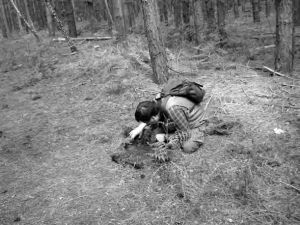 The RSPB headquarters at The Lodge, Sandy in Bedfordshire is situated on land that was originally lowland heathland dominated by dwarf shrub vegetation such as heather, a rare habitat in the UK. Small areas of heathland remain on the site and the RSPB over a number of years has sought to manage the area and restrict the growth of birch and pine. A few years ago the trust purchased further adjacent land, including an area of around 40 acres known as Sandy Warren, which consisted of dense pine plantations (a) together with smaller areas of mixed woodland (b) and including a small disused quarry and an iron age hill fort. In 2005 I was asked by Neil Renwick, the RSPB Sandy Heathlands Awareness Officer, if I would carry out an appraisal of mollusc species found in this newly acquired area. Since the area is fairly large and I had limited time at my disposal, I concentrated on sampling from a range of habitats over four visits during May and June of 2005. The soil is generally acidic, overlain in some areas with poorly draining clay providing damp areas of small pools or in ditches, but I recorded twenty four species in what was really a very brief sampling and in no way a structured survey. The species recorded are listed below and detailed records, together with habitat details, have been submitted to this Society and to the RSPB:-
The RSPB headquarters at The Lodge, Sandy in Bedfordshire is situated on land that was originally lowland heathland dominated by dwarf shrub vegetation such as heather, a rare habitat in the UK. Small areas of heathland remain on the site and the RSPB over a number of years has sought to manage the area and restrict the growth of birch and pine. A few years ago the trust purchased further adjacent land, including an area of around 40 acres known as Sandy Warren, which consisted of dense pine plantations (a) together with smaller areas of mixed woodland (b) and including a small disused quarry and an iron age hill fort. In 2005 I was asked by Neil Renwick, the RSPB Sandy Heathlands Awareness Officer, if I would carry out an appraisal of mollusc species found in this newly acquired area. Since the area is fairly large and I had limited time at my disposal, I concentrated on sampling from a range of habitats over four visits during May and June of 2005. The soil is generally acidic, overlain in some areas with poorly draining clay providing damp areas of small pools or in ditches, but I recorded twenty four species in what was really a very brief sampling and in no way a structured survey. The species recorded are listed below and detailed records, together with habitat details, have been submitted to this Society and to the RSPB:-
- Arion ater (Linn., 1758) agg.
- Arion subfuscus (Draparnaud, 1805)
- Arion fasciatus (Nilsson, 1823)
- Cochlicopa cf. lubrica (Müller, 1774)
- Cochlicopa cf. lubricella (Rossmässler, 1834)
- Discus rotundatus (Müller, 1774)
- Euconulus cf. fulvus (Müller, 1774)
- Cepaea nemoralis (Linn., 1758)
- Cornu aspersum (Müller, 1774)
- Trochulus striolatus (C. Pfeiffer, 1828)
- Lauria cylindracea (Da Costa, 1778)
- Limax maximus Linn., 1758
- Aegopinella pura (Alder, 1830)
- Aegopinella nitidula (Draparnaud, 1805)
- Nesovitrea hammonis (Ström, 1765)
- Oxychilus alliarius (Miller, 1822)
- Oxychilus navarricus s. helveticus (Blum, 1881)
- Punctum pygmaeum (Draparnaud, 1801)
- Acanthinula aculeata (Müller, 1774)
- Columella aspera Waldén, 1966
- Columella edentula (Draparnaud, 1805)
- Vitrina pellucida (Müller, 1774)
The RSPB planned to fell the majority of the plantation area to begin a major restoration project with the aim of eventually restoring the lowland heath habitat. Following my visits, during the winter of 2005/2006 20 hectares of mature Scots Pine and Douglas Fir were felled and a bordering belt of sycamores was heavily thinned (c). Neil has provided the following description of current restoration work taking place:- “The timber from the felled trees was sold and the waste – known as lop-and-top, was mulched. This autumn, due to the proximity of a fuel depot the lop-and-top will not be burned but will be scraped off, together with a layer of pine needles and bracken that had built up since the trees were planted around 90 years ago. Heather seeds, harvested from the Lodge area in 2005 have been primed for germination and are to be spread across the bared areas. Some old oak and sweet chestnut trees have survived the forestry regime, and some oaks have self-seeded into gaps in the pines. These have been retained, along with some silver birches, to provide the woodland element to the heathland mosaic.
Broadleaf saplings, grown from seeds collected on the Lower Greensand Ridge in Bedfordshire were planted in early 2006 – among the thinned sycamore areas, and under retained stands of pines. Some of the old pine stumps have been retained, to provide for fungi and invertebrates.” It will be useful to see how this work will affect the molluscs of the area and I intend to pay return visits in the future to this interesting reserve.
Acknowledgement
My thanks to Neil Renwick of the RSPB for suggesting this appraisal and for providing information and guidance.
